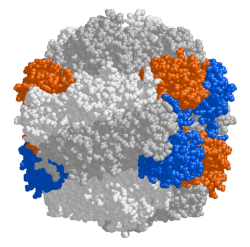Set aside, for a moment, any questions about how genetically engineered foods affect health or the environment. Set aside all the intellectual property arguments. Let’s ask a more basic question: Is genetic engineering useful? That is, is this technology fruitful enough that it merits further research?
According to the most hyperbolic rhetoric, genetic engineering is going to save the world. This is the technology that is going to liberate us from farms that run on fossil fuels. It will feed more people off fewer acres than ever before. And it will end our reliance on harmful pesticides. I say hyperbolic because no scientist I’ve talked to has ever suggested that genetic engineering is the only solution. But when the rhetoric heats up you’re likely to hear some version of this refrain: We don’t have any choice! We need this technology.
Recently, Jonathan Foley, the director of the Institute on the Environment at the University of Minnesota, made a convincing case that genetic engineering, or any kind of crop improvement actually, isn’t of primary importance. If we really wanted to feed ourselves responsibly, here’s how we’d do it: Reduce food waste, eat less meat, and make fertilizer and irrigation available to the farmers that need it.
Riffing on this reasoning, Doug Gurian-Sherman, at the Union of Concerned Scientists, took it a step further, pointing out that there is an opportunity cost to genetic engineering research. Essentially, public investments in genetic engineering eat up money and energy that we could instead be investing in more effective approaches.
So which is it? Do we have no other choice but to embrace this technology? Or is it basically the 8-track of agriculture? I wish I could argue one extreme or the other here — it would make this essay more dramatic. But as usual, the answer is: It depends. There are some goals of genetic engineering that are probably a waste of time. And then there are others that will almost certainly bear fruit.
What doesn’t work
To radically improve crops, breeders and genetic engineers have long hoped to make plants that do more with less. That is, they’d like to grow more food with less water, less fertilizer, and less light (which would allow faster growth). In his book, Darwinian Agriculture, R. Ford Denison assesses these aims and concludes that they are “likely to prove elusive.”
Here’s the reason that tradeoff-free improvements in the efficiency with which crops use light, water, or nutrients are unlikely anytime soon: These traits have already been improved by millions of years of natural selection. Any improvements that natural selection has somehow overlooked will often be too complex for today’s genetic engineers to imagine or to implement.
Denison’s point is that, when we try to reengineer organisms, we sometimes forget that evolution has almost certainly tried and rejected everything that we could think of. There’s an unrelenting Darwinian pressure pushing plants to optimize their efficiency. When we try to fix a flaw that looks inefficient, we’re likely to find that nature designed that supposed flaw for a very good reason.

How I think of rubisco.
For example, plants use an enzyme called rubisco, which grabs carbon dioxide and begins converting it to sugar. I like to think of it as a sort of pickup artist, seducing molecules. But rubisco is a sloppy pickup artist, with beer goggles: It often confusedly grabs oxygen rather than carbon dioxide, which wastes energy and slows down the entire process of photosynthesis. Scientists have called rubisco, “nearly the world’s most incompetent enzyme,” and “not one of evolution’s finest efforts.” They have suggested that we could increase its efficiency by 40 percent, leading to huge increases in yields. This would also suck more carbon out of the atmosphere.

Rubisco, actually.
It’s actually pretty easy to make rubisco more discerning. The rubisco in algae, for instance, is less likely to mistake oxygen for carbon dioxide. But there’s a big problem: As it gets pickier, rubisco slows down. It’s almost as if the enzyme is taking its time to check out its prospects on the dance floor rather than drunkenly grabbing whoever is nearest. And it turns out that rubisco is optimized to compromise between speed and pickiness to maximize efficiency. The more scientists learn, the more respect they have for the enzyme. A more recent analysis concluded that “rubiscos may be nearly perfectly adapted.”
And this sort of thing happens across the board: Whenever we try to fix things, there are always tradeoffs.
“Tradeoff-blind biotechnology mistakenly assumes that it will be relatively easy to improve plant traits that have been improved by millennia of natural selection,” Denison wrote. “[C]ontinually trying to reinvent nature’s wheels is a recipe for disaster.”
What works
If you are willing to acknowledge the tradeoffs, however, high-tech plant breeding can be wonderfully useful, Denison says. There’s a tradeoff between a corn plant putting energy into growing tall to outcompete its neighbors, and putting energy into producing more seeds. In the wild, competing with the neighbors, it’s vitally important — but on farms, it’s not. We could take that tradeoff and have thigh-high cornfields. And in fact research along those lines is progressing nicely.
And when you leave the realm of efficiency, the options open up. There’s a constant evolutionary pressure to maximize your growth efficiency, but there isn’t constant pressure to evolve disease resistance, because diseases change and fluctuate. Biotechnology has already given us several successful disease resistant plants.
Then there are approaches like engineering nutrients into plants: There’s no reason that Golden Rice would evolve on its own. And that is something within our reach — as I understand it, the plant breeders have already developed rice with useful levels of Vitamin A, they just haven’t bred this trait into varieties that are adapted to all the climates where it might be used.
We know genetic engineering is useful to farmers — the commercial market tells us that. And there are these examples here where it could do some real public good. But opponents would argue that you could use other technologies to do the same things, and that you could accomplish a greater public good, cheaper.
What’s the bang for the buck?
Is all the hyped-up excitement that comes with a new technology — and all the corporate dollars pouring into universities to fund genetic engineering research — distracting researchers from more worthy areas of inquiry?
One of the people I asked about this was Leland Glenna, a sociologist at Penn State. Biotechnology companies are funding a lot of research at universities, and some say this is a good thing. Industry-funded labs do produce proprietary research, but they also produce a lot of good public science that wouldn’t be available otherwise.
There’s a bigger concern, however, about the way corporate funding influences the interests and values of public scientists. Glenna’s research suggests that, when there’s plenty of funding for a private-sector research topic, public research begins to mirror these topics. There’s now a strong incentive in public universities for scientists to produce findings that are marketable.
But Glenna doesn’t blame this on genetic engineering: The problem is that there’s just not enough public funding, he said. If there was more public funding, some of it should almost certainly go to research that involves neglected areas of biotech. Glenna points out that the National Research Council found that public money should be spent on biotechnology that might help farmers to adapt to climate change, for example.
And even Doug Gurian-Sherman isn’t saying that GE is such an inefficient tool that we should simply throw it out. When I emailed him about this, he wrote:
I am also not suggesting that a particular limit be placed on funding for GE vs. other types of ag research, but only that opportunity costs are considered carefully as part of the equation.
Alexander J. Stein, an agricultural economist at the International Food Policy Research Institute, specializes in the weighing of opportunity costs, and he agrees with Gurian-Sherman in this. Sure, there are cases where GE is less cost-effective, he explained to me in an email, but not all cases. Instead of asking “Should we use genetic engineering?”, we should be asking which projects are cost effective. And, in fact, organizations like the United Nations and the World Bank have set up rigorous criteria for weighing opportunity costs: “So projects that meet those criteria should be funded (whether GE or alternative) and those that don’t should not,” Stein wrote.
It’s not very exciting to say that each avenue of research project should be funded on its merits. It would be much more powerful if I could make the case that GE food can just never deliver as much public good as money spent elsewhere. But there’s just not good evidence for that the case.
Indeed, it’s clear that genetic engineering can provide a huge monetary return on investment. The success of commercial biotech hints that the technology also could provide return on investment for the environment, and for humanity, if we pursued the right avenues. We don’t need GMOs to save the world. But they could probably help.
Panic-free GMOS: See the full story list



